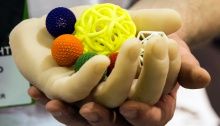Production of Russian 3D printers stumbles on stereotypes

Newborn Russian 3D industry can become competitive and large-scale, if ordinary consumers will see low cost and advantages of the new mode of production, and large companies will increasingly apply this mode. In the meantime, the market is growing thanks mobile small and medium sized companies and educational institutions.
It is highly entertaining to watch the birth of a new kind of production, especially taking into account the fact this is innovative. In Russia desktop 3D printers are being developed for three years already, and first sales began in late 2011. During this time, six companies marketed their products! On the one hand, everybody considers this market growing and very promising. On the other hand, large business is not interested in a new market niche. However, production of 3D printers has become a lot of not only small but also medium-sized enterprises. But will Russian production of 3D printers survive? One of the threatening trends is increasing competition from foreign manufacturers: this spring, some market participants started talking about the beginning of price war.
Another factor is conservatism of potential buyers, who could be numerous research institutes, design bureaus and MIC enterprises. But there is a positive trend too: this year, education system (of both professional and additional education) began to actively buy 3D printers. This year wealthy Russians noticed "magic printing" and began buying 3D printers for home use. For now it is just fun - one can "print" any toy, cup, spoon or even shoes. But soon many will realize that 3D printer at home is the same need as computer is. And domestic companies have the opportunity to participate in emerging 3D boom.
Explosive growth of 3D printing
History of 3D printing goes to 1948, when American Charles Hull developed technology called “stereolithography” (STL). However, Hull obtained a patent for his invention only in 1986. Then he founded 3D System and began to develop the first commercial device for three-dimensional printing, its prototype was presented a year later. It made Hull a multibillionaire. His device was “growing” modeled on the computer three dimensional object out of liquid photopolymerizable, applying it layer by layer on moving platform.

In the late nineties, other 3D printing technologies was developed - selective laser sintering (SLS), which allows producing objects made of metal, ceramic and gypsum powder. Then there was a method of used deposition modeling (FDM). FDM works on an "additive" principle by laying down material in layers; a plastic filament or metal wire is unwound from a coil and supplies material to produce a part.
In 2005 in the U.S. there was RepRap project - self-replicating device that can be used for rapid prototyping and production. RepRap device is a 3D printer capable of producing three-dimensional artifacts from computer generated models. One of the goals of the project is "self-replication", the authors define it as the ability of machine to produce components needed to create another version of itself.

After 2008, when Hull patent runs out, STL technology which became open and others like it, along with RepRap technology enabled thousands of companies worldwide earning. Printers are in demand. Companies added some modification to components and branded existing printers. This is how 3D boom started: market grew by 50%, and in some places by 150% per year.
Recent years companies have moved from production of large and expensive printers for industrial enterprises (price one hundred thousand dollars and more) to new segment - production of small cheap "desktop" printers that can be used even in the home. As a rule, in most “desktop” 3D printers polymer filament is applied layer after layer.
Ground breakers
It is significant that in Russia first domestic 3D printer was produced not by industry monsters. It was made by enthusiastic students from Zelenograd. It all started with the robot. Fourth year students of the Moscow Institute of Electronic Technology (MIET) Andrey Isupov and Maxim Anisimov defended thesis and created six-fingered multi-functional robot.







